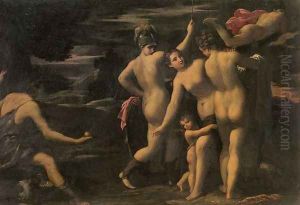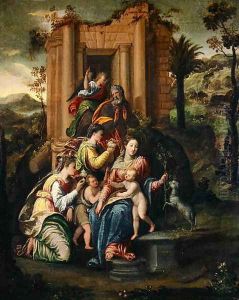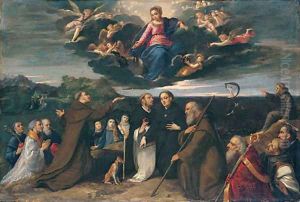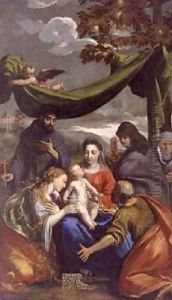Sigismondo (Mondino) Scarsellino Paintings
Sigismondo Scarsellino, also known as Mondino Scarsellino or simply Scarsellino, was an Italian painter of the late Renaissance period, active mainly in his native city of Ferrara, Italy. Born in 1550 into a family with artistic connections—his father was the painter Giovanni Battista Scarsella—Scarsellino is often noted for his distinctive style that melds the local Ferrarese traditions with the influence of the Venetian School.
Scarsellino worked under the tutelage of his father initially but was also greatly influenced by the works of the renowned painter Dosso Dossi, who had previously been the court painter for the Este family in Ferrara. Scarsellino's work is characterized by a softness of form, a richness in color, and an elegance in his figures, traits that reflect the influence of the Venetian School, and in particular, the work of Titian. His travels to Venice were significant in forming his artistic vocabulary, which elegantly combined Venetian colorism with the Mannerist style that was prevalent during his time.
Throughout his career, Scarsellino completed numerous altarpieces, mythological scenes, and religious works that showcase his ability to create dramatic compositions with vibrant colors and dynamic figures. Notable works include his frescoes in the Palazzo dei Diamanti in Ferrara and the 'Feast of the Gods' at the Villa Imperiale of Pesaro. He also contributed to the decoration of the Ferrara Cathedral with paintings such as the 'Assumption of the Virgin'.
Scarsellino's work was well-regarded by his contemporaries, and he received commissions from prominent patrons, including the Este family. His paintings were influential in the Ferrara region and also attracted attention from collectors and artists beyond his hometown. Despite this, his work did not gain the same level of fame as some of his contemporaries, and he remained a somewhat regional artist.
Scarsellino continued to paint until his death in 1620, leaving behind a legacy that reflects the transitional period between the Renaissance and Baroque styles. His works can be found in various Italian museums and churches, as well as in collections around the world, serving as enduring examples of the richness of late Renaissance art in Northern Italy.



